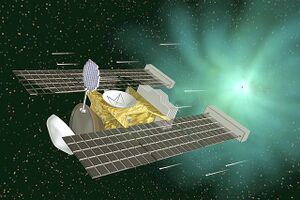Stardust (spacecraft) (nonfiction): Difference between revisions
(Created page with "Stardust was a 300 kilogram robotic space probe launched by NASA on 7 February 1999. Its primary mission was to collect dust samples from the coma of comet Wild 2, as well as...") |
No edit summary |
||
| Line 1: | Line 1: | ||
Stardust was a 300 kilogram robotic space probe launched by NASA on 7 February 1999. Its primary mission was to collect dust samples from the coma of comet Wild 2, as well as samples of cosmic dust, and return these to Earth for analysis. | [[File:Stardust at comet Wild 2.jpg|thumb|Artist's impression of Stardust at comet Wild 2.]]'''Stardust''' was a 300 kilogram robotic space probe launched by NASA on 7 February 1999. Its primary mission was to collect dust samples from the coma of comet Wild 2, as well as samples of cosmic dust, and return these to Earth for analysis. | ||
A mission extension codenamed NExT culminated in February 2011 with Stardust intercepting comet Tempel 1, a small Solar System body previously visited by Deep Impact in 2005. Stardust ceased operations in March 2011. | En route to comet Wild 2, the craft also flew by and studied the asteroid 5535 Annefrank. | ||
The primary mission was successfully completed on 15 January 2006, when the sample return capsule returned to Earth. It was the first sample return mission of its kind. | |||
A mission extension codenamed NExT culminated in February 2011 with Stardust intercepting comet Tempel 1, a small Solar System body previously visited by Deep Impact in 2005. | |||
Stardust ceased operations in March 2011. | |||
On 14 August 2014, scientists announced the identification of possible interstellar dust particles from the Stardust capsule returned to Earth in 2006. | On 14 August 2014, scientists announced the identification of possible interstellar dust particles from the Stardust capsule returned to Earth in 2006. | ||
| Line 12: | Line 18: | ||
== Fiction cross-reference == | == Fiction cross-reference == | ||
* [[Crimes against | * [[Crimes against astronomical constants]] | ||
* [[Gnomon algorithm]] | * [[Gnomon algorithm]] | ||
== Nonfiction cross-reference == | == Nonfiction cross-reference == | ||
* [[ (nonfiction)]] | * [[Spacecraft (nonfiction)]] | ||
External links: | External links: | ||
* [ Stardust (spacecraft)] @ Wikipedia | * [https://en.wikipedia.org/wiki/Stardust_(spacecraft) Stardust (spacecraft)] @ Wikipedia | ||
[[Category:Nonfiction (nonfiction)]] | [[Category:Nonfiction (nonfiction)]] | ||
[[Category:Machines (nonfiction)]] | [[Category:Machines (nonfiction)]] | ||
[[Category:Spacecraft (nonfiction)]] | [[Category:Spacecraft (nonfiction)]] | ||
Revision as of 15:46, 13 January 2018
Stardust was a 300 kilogram robotic space probe launched by NASA on 7 February 1999. Its primary mission was to collect dust samples from the coma of comet Wild 2, as well as samples of cosmic dust, and return these to Earth for analysis.
En route to comet Wild 2, the craft also flew by and studied the asteroid 5535 Annefrank.
The primary mission was successfully completed on 15 January 2006, when the sample return capsule returned to Earth. It was the first sample return mission of its kind.
A mission extension codenamed NExT culminated in February 2011 with Stardust intercepting comet Tempel 1, a small Solar System body previously visited by Deep Impact in 2005.
Stardust ceased operations in March 2011.
On 14 August 2014, scientists announced the identification of possible interstellar dust particles from the Stardust capsule returned to Earth in 2006.
In the News
Fiction cross-reference
Nonfiction cross-reference
External links:
- Stardust (spacecraft) @ Wikipedia
